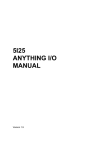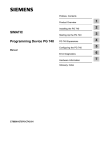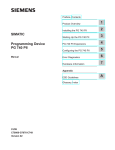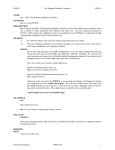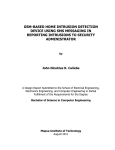Download 6I25 ANYTHING I/O MANUAL
Transcript
6I25 ANYTHING I/O MANUAL Version 1.4 This page intentionally not blank Table of Contents GENERAL . . . . . . . . . . . . . . . . . . . . . . . . . . . . . . . . . . . . . . . . . . . . . . . . . . . . . . . . . . 1 DESCRIPTION . . . . . . . . . . . . . . . . . . . . . . . . . . . . . . . . . . . . . . . . . . . . . . . . . 1 HARDWARE CONFIGURATION . . . . . . . . . . . . . . . . . . . . . . . . . . . . . . . . . . . . . . . . 2 GENERAL . . . . . . . . . . . . . . . . . . . . . . . . . . . . . . . . . . . . . . . . . . . . . . . . . . . . BREAKOUT POWER OPTION . . . . . . . . . . . . . . . . . . . . . . . . . . . . . . . . . . . . . 5V I/O TOLERANCE . . . . . . . . . . . . . . . . . . . . . . . . . . . . . . . . . . . . . . . . . . . . PRECONFIG PULL-UP ENABLE . . . . . . . . . . . . . . . . . . . . . . . . . . . . . . . . . . . PCICLOCK SELECTION . . . . . . . . . . . . . . . . . . . . . . . . . . . . . . . . . . . . . . . . . BRIDGE EEPROM ENABLE . . . . . . . . . . . . . . . . . . . . . . . . . . . . . . . . . . . . . . 2 2 2 3 3 3 CONNECTORS . . . . . . . . . . . . . . . . . . . . . . . . . . . . . . . . . . . . . . . . . . . . . . . . . . . . . . 4 CONNECTOR LOCATIONS AND DEFAULT JUMPER POSITIONS . . . . . . . . 4 6I25 I/O CONNECTOR PIN-OUT . . . . . . . . . . . . . . . . . . . . . . . . . . . . . . . . . . . 5 JTAG CONNECTOR PIN-OUT . . . . . . . . . . . . . . . . . . . . . . . . . . . . . . . . . . . . . 7 OPERATION . . . . . . . . . . . . . . . . . . . . . . . . . . . . . . . . . . . . . . . . . . . . . . . . . . . . . . . . 8 5I25 COMPATIBILITY . . . . . . . . . . . . . . . . . . . . . . . . . . . . . . . . . . . . . . . . . . . 8 FPGA . . . . . . . . . . . . . . . . . . . . . . . . . . . . . . . . . . . . . . . . . . . . . . . . . . . . . . . . 8 FPGA PINOUT . . . . . . . . . . . . . . . . . . . . . . . . . . . . . . . . . . . . . . . . . . . . . . . . . 8 PCIE ACCESS . . . . . . . . . . . . . . . . . . . . . . . . . . . . . . . . . . . . . . . . . . . . . . . . . 8 CONFIGURATION . . . . . . . . . . . . . . . . . . . . . . . . . . . . . . . . . . . . . . . . . . . . . . 9 EEPROM LAYOUT . . . . . . . . . . . . . . . . . . . . . . . . . . . . . . . . . . . . . . . . . . . . . . 9 BIT FILE FORMAT . . . . . . . . . . . . . . . . . . . . . . . . . . . . . . . . . . . . . . . . . . . . . 12 MFLASH . . . . . . . . . . . . . . . . . . . . . . . . . . . . . . . . . . . . . . . . . . . . . . . . . . . . . 12 MESAFLASH . . . . . . . . . . . . . . . . . . . . . . . . . . . . . . . . . . . . . . . . . . . . . . . . . 12 SPI INTERFACE DESCRIPTION . . . . . . . . . . . . . . . . . . . . . . . . . . . . . . . . . . 13 FREE EEPROM SPACE . . . . . . . . . . . . . . . . . . . . . . . . . . . . . . . . . . . . . . . . 14 FALLBACK INDICATION . . . . . . . . . . . . . . . . . . . . . . . . . . . . . . . . . . . . . . . . 14 FAILURE TO CONFIGURE . . . . . . . . . . . . . . . . . . . . . . . . . . . . . . . . . . . . . . 14 CLOCK SIGNALS . . . . . . . . . . . . . . . . . . . . . . . . . . . . . . . . . . . . . . . . . . . . . . 14 LEDS . . . . . . . . . . . . . . . . . . . . . . . . . . . . . . . . . . . . . . . . . . . . . . . . . . . . . . . 15 PULLUP RESISTORS . . . . . . . . . . . . . . . . . . . . . . . . . . . . . . . . . . . . . . . . . . 15 I/O LEVELS . . . . . . . . . . . . . . . . . . . . . . . . . . . . . . . . . . . . . . . . . . . . . . . . . . 15 STARTUP I/O VOLTAGE . . . . . . . . . . . . . . . . . . . . . . . . . . . . . . . . . . . . . . . . 15 INTERFACE CABLES . . . . . . . . . . . . . . . . . . . . . . . . . . . . . . . . . . . . . . . . . . 16 BREAKOUT POWER OPTION . . . . . . . . . . . . . . . . . . . . . . . . . . . . . . . . . . . . 16 PLUG AND GO KITS . . . . . . . . . . . . . . . . . . . . . . . . . . . . . . . . . . . . . . . . . . . 16 iii Table of Contents SUPPLIED CONFIGURATIONS . . . . . . . . . . . . . . . . . . . . . . . . . . . . . . . . . . . . . . . . 17 HOSTMOT2 . . . . . . . . . . . . . . . . . . . . . . . . . . . . . . . . . . . . . . . . . . . . . . . . . . 7I76X2 . . . . . . . . . . . . . . . . . . . . . . . . . . . . . . . . . . . . . . . . . . . . . . . . . . . . . . 7I76_7I74 . . . . . . . . . . . . . . . . . . . . . . . . . . . . . . . . . . . . . . . . . . . . . . . . . . . . G540X2 . . . . . . . . . . . . . . . . . . . . . . . . . . . . . . . . . . . . . . . . . . . . . . . . . . . . . 7I77X2 . . . . . . . . . . . . . . . . . . . . . . . . . . . . . . . . . . . . . . . . . . . . . . . . . . . . . . 7I77_7I76 . . . . . . . . . . . . . . . . . . . . . . . . . . . . . . . . . . . . . . . . . . . . . . . . . . . . 7I77_7I74 . . . . . . . . . . . . . . . . . . . . . . . . . . . . . . . . . . . . . . . . . . . . . . . . . . . . 7I74X2 . . . . . . . . . . . . . . . . . . . . . . . . . . . . . . . . . . . . . . . . . . . . . . . . . . . . . . 7I78X2 . . . . . . . . . . . . . . . . . . . . . . . . . . . . . . . . . . . . . . . . . . . . . . . . . . . . . . PROB_RFX2 . . . . . . . . . . . . . . . . . . . . . . . . . . . . . . . . . . . . . . . . . . . . . . . . . PIN FILES . . . . . . . . . . . . . . . . . . . . . . . . . . . . . . . . . . . . . . . . . . . . . . . . . . . 17 17 17 17 17 17 18 18 18 18 18 REFERENCE INFORMATION . . . . . . . . . . . . . . . . . . . . . . . . . . . . . . . . . . . . . . . . . 19 SPECIFICATIONS . . . . . . . . . . . . . . . . . . . . . . . . . . . . . . . . . . . . . . . . . . . . . 19 iv GENERAL DESCRIPTION The MESA 6I25 SuperPort is a low cost, general purpose programmable I/O card for the PCIE bus. The 6I25 is a low profile one lane PCIE card and is available with standard or low profile brackets. The 6I25 uses standard parallel port pinouts and connectors for compatibility with most parallel port interfaced motion control / CNC breakout cards, allowing a motion control performance boost while retaining a reliable real time PCI interface. The 6I25 provides 34 I/O bits (17 per connector). All I/O bits have bus switches that provide 5V tolerance and also have the benefit of disconnecting all I/O pins when the host CPU is off, preventing damage to the 6I25 if power is supplied to I/O pins when the host is powered down. All I/O pins have pull-up resistors, so have a defined state at power up. Unlike the parallel port that the 6I25 replaces, each I/O bit has individually programmable direction and function. A power source option allows the 6I25 to supply 5V power to breakout boards if desired. This 5V power is protected by a per connector PTC. Configurations are provided for hardware step generation (to MHz rates), encoder counting, PWM, digital I/O, analog I/O, and Smart Serial remote I/O.Configurations are available that are compatible with common breakout cards and multi axis step drives like the Probotix-RF and the Gecko G540. There are currently six 6I25 compatible breakout cards available from Mesa, the 7I74 through 7I85. 6I25 1 HARDWARE CONFIGURATION GENERAL Hardware setup jumper positions assume that the 6I25 card is oriented in an upright position, that is, with the PCIE connector towards the person doing the configuration. BREAKOUT POWER OPTION The 6I25 has the option to supply 5V power from the host computer to the breakout board. This option is used by all Mesa breakout boards to simplify wiring. The option uses 4 parallel cable signals that are normally used as grounds for supplying 5V to the remote breakout board (DB25 pins 22,23,24 and 25). These pins are AC bypassed on both the 6I25 and Mesa breakout cards so do not compromise AC signal integrity. The 5V power option is individually selectable for the two I/O connectors. The breakout 5V power is protected by per connector PTC devices so will not cause damage to the 6I25 or system if accidentally shorted. This option should only be enabled for Mesa breakout boards or boards specifically wired to accept 5V power on DB25 pins 22 through 25. When the option is disabled DB25 pins 22 through 25 are grounded W1 (P2 POWER ) W2 (P3 POWER) UP UP BREAKOUT POWER ENABLED DOWN, DOWN BREAKOUT POWER DISABLED (DEFAULT) 5V I/O TOLERANCE The FPGA used on the 6I25 has a 4V absolute maximum input voltage specification. To allow interfacing with 5V inputs, the 6I25 has bus switches on all I/O pins. The bus switches work by turning off when the input voltage exceeds a preset threshold. The 5V I/O tolerance option is the default and should normally be left enabled. For high speed applications where only 3.3V maximum signals are present and overshoot clamping is desired, the 5V I/O tolerance option can be disabled. W3 controls the 5V I/O tolerance option. When W3 is on the default UP position, 5V tolerance mode is enabled. When W3 is in the DOWN position, 5V tolerance mode is disabled. Note that W3 controls 5V tolerance on both P2 and P3 I/O connectors. W3 also selects the pull-up resistor voltage, When 5V I/O tolerance mode is selected, the I/O pull-up resistors are powered from 5V. When 5V I/O tolerance mode is disabled, the I/O pull-up resistors are powered with 3.3V. 6I25 2 HARDWARE CONFIGURATION PRECONFIG PULLUP ENABLE The Xilinx FPGA on the 6I25 has the option of having weak pull-ups on all I/O pins at power-up or reset. The default is to enable the pull-ups To enable the built-in pull-ups, (the default condition) jumper W4 should be placed in the UP position. To disable the internal pull-ups, W4 should be in the DOWN position. PCI BUS CLOCK SELECTION The 6I25 uses a PCIE to PCI bridge chip to interface its FPGA to the PCIE bus. This bridge chip has selectable PCI bus speeds. Jumpers W8 and W7 select the local PCI bus clock. W7 W8 PCI CLOCK DOWN DOWN 25 MHz DOWN UP 33 MHz UP DOWN 50 MHz UP UP 66 MHz NOTE DEFAULT 5I25 COMPATIBLE 6I25 COMPATIBLE Note that 33MHz must be selected to be able to use 5I25 bitfiles, and 66 MHz must be selected in order use 6I25 bitfiles. BRIDGE EEPROM ENABLE The 6I25's PCIE bridge has a serial EEPROM to allow storage of bridge setup options. Since its possible to disable the card with incorrect EEPROM setup options, a jumper is provided to disable the EEPROM, and thereby load default parameters in case the EEPROM is corrupted/programmed incorrectly. Jumper W5 determines if the bridge loads its setup options from the EEPROM or uses default options. When W5 is in the UP position (default) the bridge chip will load its option from the EEPROM. When W5 is in the DOWN position, the bridge will not read the EEPROM and instead use its internal defaults. 6I25 3 CONNECTORS CONNECTOR LOCATIONS AND DEFAULT JUMPER POSITIONS 6I25 4 CONNECTORS I/O CONNECTORS The 6I25 has 2 I/O connectors, the primary DB25F connector P3 and the secondary 26 pin header connector P2, please see the 6I25IO.PIN file on the 6I25 distribution disk. 6I25 IO connector pinouts are as follows: P3 BACK PANEL DB25F CONNECTOR PINOUT DB25 PIN FUNCTION DB25 PIN FUNCTION 1 IO0 14 IO1 2 IO2 15 IO3 3 IO4 16 IO5 4 IO6 17 IO7 5 IO8 18 GND 6 IO9 19 GND 7 IO10 20 GND 8 IO11 21 GND 9 IO12 22 GND or 5V 10 IO13 23 GND or 5V 11 IO14 24 GND or 5V 12 IO15 25 GND or 5V 13 IO16 6I25 5 CONNECTORS I/O CONNECTORS P2 INTERNAL HDR26 CONNECTOR PINOUT HDR PIN FUNCTION HDR PIN FUNCTION 1 IO17 2 IO18 3 IO19 4 IO20 5 IO21 6 IO22 7 IO23 8 IO24 9 IO25 10 GND 11 IO26 12 GND 13 IO27 14 GND 15 IO28 16 GND 17 IO29 18 GND or 5V 19 IO30 20 GND or 5V 21 IO31 22 GND or 5V 23 IO32 24 GND or 5V 25 IO33 26 GND or 5V Note: 26 pin header P2 will match standard parallel port pin-out if terminated with flat cable 26 pin receptacle/DB25F cable with pin1s connected (and header pin 26 left open) A cable/bracket hardware kit is available from MESA for the second port. 6I25 6 CONNECTORS JTAG CONNECTOR PINOUT P1 is a JTAG programming connector. This is normally used only for debugging .For debugging, the card can be powered in a standard PCIE slot or if desired, 3.3V power can be applied via the JTAG connector. P1 JTAG CONNECTOR PINOUT PIN FUNCTION 1 TMS 2 TDI 3 TDO 4 TCK 5 GND 6 +3.3V 6I25 7 OPERATION 5I25 COMPATIBILITY The 6I25 can be completely software compatible with the 5I25 if 5I25 bitfiles are loaded in the 6I25's EEPROM, and its PCI clock is set for 33 MHz. This is the current default setup of 6I25 cards. Configured this way, the 6I25 will report itself as a 5I25 and will be completely compatible with 5I25 software. These is a small speed advantage and some additional 6I25 features available if the card is runs as a native 6I25. To do this, a 6I25 bitfile must be loaded in the 6I25's EEPROM, and the local PCI clock set to 66MHz. FPGA The 6I25 use a Xilinx Spartan6 ~400k gate FPGA in a 144 pin QFP package: XC6SLX9-PQ144. FPGA PINOUT The local bus and I/O interface FPGA pinouts are described in the 6i25.ucf file in the /configs/hostmot2/source directory of the 5i25.zip file. PCIE ACCESS The 6I25 normally uses 5I25 or 6I25 specific HostMot2 firmware which currently has a simple target only PCI core with a single Base Address Register (BAR 0). Card specific PCI identifiers are as follows: VENDOR ID 0X2718 DEVICE ID (5I25 mode) 0x5125 DEVICE ID (6I25 mode) 0x6125 SUBSYSTEM VENDOR ID 0x2718 SUBSYSTEM DEVICE ID (5I25 mode) 0x5125 SUBSYSTEM DEVICE ID (6I25 mode) 0x6125 The single base address register (BAR0) maps a 64K Byte region of non-cacheble 32 bit wide memory. . 6I25 8 OPERATION CONFIGURATION The 6I25 is configured at power up by a SPI EEPROM. This EEPROM is an 8M bit chip that has space for two configuration files. Since there is a PCIE bridge chip with GPIO bits available, the 6I25 can be programmed even if the serial EEPROM is blank or corrupted, however this requires bit-banging every serial data bit and is quite slow. For this reason the 6I25 EEPROM normally contains two configuration file images, A primary user image and a fallback image. If the primary user configuration is corrupted, the FPGA will load the fallback configuration so the EEPROM image can be repaired via a fast SPI interface in the FPGA instead of having to resort to bit banging. EEPROM LAYOUT The EEPROM used on the 6I25 for configuration storage is the M25P80 or M25P16. The M25P80 is a 8 M bit (1 M byte) EEPROM with 16x 64K byte sectors. The M25P16 is a 16 Mbit (2 M byte) EEPROM with 32x 64K byte sectors Configuration files are stored on sector boundaries to allow individual configuration file erasing and updating. M25P80 EEPROM sector layout is as follows: 0x00000 BOOT BLOCK 0x10000 FALLBACK CONFIGURATION BLOCK 0 0x20000 FALLBACK CONFIGURATION BLOCK 1 0x30000 FALLBACK CONFIGURATION BLOCK 2 0x40000 FALLBACK CONFIGURATION BLOCK 3 0x50000 FALLBACK CONFIGURATION BLOCK 4 0x60000 FALLBACK CONFIGURATION BLOCK 5 0x70000 RESERVED 0x80000 USER CONFIGURATION BLOCK 0 0x90000 USER CONFIGURATION BLOCK 1 0xA0000 USER CONFIGURATION BLOCK 2 0xB0000 USER CONFIGURATION BLOCK 3 0xC0000 USER CONFIGURATION BLOCK 4 0xD0000 USER CONFIGURATION BLOCK 5 0xE0000 UNUSED/FREE 0xF0000 UNUSED/FREE 6I25 9 OPERATION EEPROM LAYOUT The first half of M25P16 sector layout is as follows: 0x00000 BOOT BLOCK 0x10000 FALLBACK CONFIGURATION BLOCK 0 0x20000 FALLBACK CONFIGURATION BLOCK 1 0x30000 FALLBACK CONFIGURATION BLOCK 2 0x40000 FALLBACK CONFIGURATION BLOCK 3 0x50000 FALLBACK CONFIGURATION BLOCK 4 0x60000 FALLBACK CONFIGURATION BLOCK 5 0x70000 RESERVED 0x80000 UNUSED/FREE 0x90000 UNUSED/FREE 0xA0000 UNUSED/FREE 0xB0000 UNUSED/FREE 0xC0000 UNUSED/FREE 0xD0000 UNUSED/FREE 0xE0000 UNUSED/FREE 0xF0000 UNUSED/FREE 6I25 10 OPERATION EEPROM LAYOUT The second half of M25P16 sector layout is as follows: 0x100000 USER CONFIGURATION BLOCK 0 0x110000 USER CONFIGURATION BLOCK 1 0x120000 USER CONFIGURATION BLOCK 2 0x130000 USER CONFIGURATION BLOCK 3 0x140000 USER CONFIGURATION BLOCK 4 0x150000 USER CONFIGURATION BLOCK 5 0x160000 UNUSED/FREE 0x170000 UNUSED/FREE 0x180000 UNUSED/FREE 0x190000 UNUSED/FREE 0x1A0000 UNUSED/FREE 0x1B0000 UNUSED/FREE 0x1C0000 UNUSED/FREE 0x1D0000 UNUSED/FREE 0x1E0000 UNUSED/FREE 0x1F0000 UNUSED/FREE 6I25 11 OPERATION BITFILE FORMAT The configuration utilities expects standard FPGA bitfiles without any multiboot features enabled. If multiboot FPGA files are loaded they will likely cause a configuration failure. In addition for fallback to work, the -g next_config_register_write:disable, -g reset_on_error:enable and -g CRC:enable bitgen options must be set. NMFLASH The DOS utility program NMFLASH is provided to write configuration files to the 6I25 EEPROM under DOS. NMFLASH depends on a simple SPI interface built into both the standard user FPGA bitfiles and the fallback bitfile. NMFLASH FPGAFILE.BIT Writes a standard bitfile FPGAFILE.BIT to the user area of the EEPROM NMFLASH FPGAFILE.BIT V Verifies the user EEPROM configuration against the bit file FPGAFILE.BIT NMFLASH FALLBACK.BIT FallBack Writes the fallback EEPROM configuration to the fallback area of the EEPROM. In addition if the bootblock is not present in block 0 of the EEPROM, it re-writes the bootblock. MESAFLASH Linux and Windows utility programs mesaflash and mesaflash.exe are provided to write configuration files to the 6I25 EEPROM. These files depend on a simple SPI interface built into both the standard user FPGA bitfiles and the fallback bitfile. If mesaflash is run with a Bhelp command line it will print usage information. mesaflash --device 5I25 --write FPGAFILE.BIT Writes a standard bitfile FPGAFILE.BIT to the user area of the EEPROM. mesaflash --device 5I25 --verify FPGAFILE.BIT Verifies the user EEPROM configuration against the bit file FPGAFILE.BIT. mesaflash --device 5I25 --fallback --write FALLBACK.BIT Writes a fallback file to the fallback area of the EEPROM. 6I25 12 OPERATION SPI INTERFACE DESCRIPTION This is the register level description of the simple SPI interface to the 6I25's configuration EEPROM. This hardware is built into all Mesa 6I25 configurations. This information is only needed if you are writing your own programming utility. DATA REGISTER at offset 0x74 from 6I25 base address D7 D6 D5 D4 D3 D2 D1 D0 R/W R/W R/W R/W R/W R/W R/W R/W CONTROL REGISTER at offset 0x70 from 6I25 base address X X X X X DAV BUSY CS X X X X X R/O R/O R/W 6I25 13 OPERATION SPI INTERFACE DESCRIPTION The SPI interface is very minimal, just enough hardware to avoid slow bit banging of the SPI data when reading or writing the configuration EEPROM. Operation is as follows: To transfer SPI data, CS is asserted low and an outgoing command/data byte is written to the data register. This write to the data register causes the SPI interface to clear its DAV bit, shift out its outgoing data byte, and shift in its incoming data. This shifting is done at a fixed PCI Clock/3 rate or about 11 MHz. When the byte data transfer is done, The DAV bit is set in the control register. Host software can poll this bit to determine when the transfer is done. When the transfer is done the incoming data from the EEPROM can be read in the data register, and the next byte sent out. Note that CS operation is entirely controlled by the host, that is for example with a 5 byte command sequence, the host must assert CS low, transfer 5 bytes with 5 write/read commands to the data register with per byte DAV bit polling and finally assert CS high when done. FREE EEPROM SPACE Three 64K byte blocks of EEPROM space are free when both user and fallback configurations are installed. It is suggested that only the last two blocks, 0xE0000 and 0xF0000 in the user area, be used for FPGA application EEPROM storage. FALLBACK INDICATION Mesa’s supplied fallback configurations blink the red INIT LED on the top right hand side of the card if the primary configuration fails and the fallback configuration loaded successfully. If this happens it means the user configuration is corrupted or not a proper configuration for the 6I25s FPGA. This can be fixed by running the configuration utility and re-writing the user configuration. FAILURE TO CONFIGURE The 6I25 should configure its FPGA within a fraction of a second of power application. If the FPGA card fails to configure, both red LEDs on the right hand side of the card will remain illuminated after power up. If this happens the 6I25s EEPROM must be re-programmed via the slow GPIO bitbanged method with SMFLASH. CLOCK SIGNALS The 6I25 has two FPGA clock signals. One is the PCI clock and the other is a 50 MHz crystal oscillator on the 6I25 card. Both clocks a can be multiplied and divided by the FPGAs clock generator block to generate a wide range of internal clock signals. Note tha the PCI clock rate is selectable via W7 and W8. 6I25 14 OPERATION LEDS The 6I25 has 2 FPGA driven user LEDs (User 0 and User 1 = Green), and 2 status LEDs (red). The user LEDs can be used for any purpose, and can be helpful as a simple debugging feature. A low output signal from the FPGA lights the LED. See the 6I25IO.PIN file for FPGA pin locations of the LED signals. The status LEDs reflect the state of the FPGA’s DONE, and /INIT pins. The /DONE LED lights until the FPGA is configured at power-up. The /INIT LED lights when the power on reset is asserted, when there has been a CRC error during configuration. When using Mesas configurations, the /INIIT LED blinks when the fallback configuration has been loaded. PULLUP RESISTORS All I/O pins are provided with pull-up resistors to allow connection to open drain, open collector, or OPTO devices. These resistors have a value of 3.3K so have a maximum pull-up current of 1.5 mA (5V pull-up) or 1 mA (3.3V pull-up). IO LEVELS The Xilinx FPGAs used on the 6I25 have programmable I/O levels for interfacing with different logic families. The 6I25 does not support use of the I/O standards that require input reference voltages. All standard Mesa configurations use LVTTL levels. Note that even though the 6I25 can tolerate 5V signal inputs, its outputs will not swing to 5V. The outputs are push pull CMOS that will drive to the output supply rail of 3.3V. This is sufficient for TTL compatibility but may cause problems with some types of loads. For example when driving an LED that has its anode connected to 5V, in such devices as OPTO isolators and I/O module rack SSRs, the 3.3V high level may not completely turn the LED off. To avoid this problem, either drive loads that are ground referred, Use 3.3V as the VCC for VCC referred loads, or use open drain mode. STARTUP I/O VOLTAGE After power-up or system reset and before the the FPGA is configured, the pull-up resistors will pull all I/O signals to a high level. If the FPGA is used for motion control or controlling devices that could present a hazard when enabled, external circuitry should be designed so that this initial state results in a safe condition. 6I25 15 OPERATION INTERFACE CABLES Mesa daughtercards use a male to male DB25 cable to interface to the 6I25. For noise immunity and signal fidelity it is suggested that only IEEE-1284 rated cables be used. IEEE-1284 rated cables have a twisted pair shield wire for each signal wire and an overall shield terminated in the metal connector shell. This results in much better performance than flat or NON-IEEE-1284 parallel port cables For short connections of less than 3 feet, flat cables can be used. No other type of cable should be used. Mesa can supply IEEE-1284 cables tested with the 6I25 / daughtercard combination in 6 and 10 foot lengths. BREAKOUT POWER OPTION When used with Mesa breakout/daughter cards, the 6I25 can supply up to 1A of 5V power to each of the daughter cards. This option is disabled by default to avoid possible damage to standard breakout boards, so must be specifically enabled for Mesa daughtercards. If you use this option you must verify that the interface cable does not tie the eight parallel port ground wires together as some cheap printer cables do. Mesa supplied IEEE-1284 cables are the best option for Mesa daughter cards and are guaranteed to work with the power option. Flat cable will work as well but have poorer noise immunity and signal fidelity. PLUG AND GO KITS Motion control kits with pre-programmed 6I25, interface cable, and daughtercard(s) are available to simplify system integration. 6I25 16 SUPPLIED CONFIGURATIONS HOSTMOT2 All supplied configurations are part of the HostMot2 motion control firmware set. All HostMot2 firmware is open source and easily extendible to support new interfaces or different sets of interfaces embedded in one configuration. For detailed register level information on Hostmot2 firmware modules, see the regmap file in the hostmot2 source code directory. 7I76X2 7I76X2 is a configuration intended to work with the 7I76 five axis step/dir daughtercard. It will support two 7I76 daughtercards, one on each of the 6I25s I/O connectors. The configuration includes ten hardware step generators, two encoder inputs and four Smart Serial interfaces, a watchdog timer and GPIO. 7I76_7I74 7I76_7I74 is a configuration for one 7I76 five axis step/dir daughtercards on P3 and one 7I74 eight channel RS-422 interface on P2. The 7I74 is configured with eight Smart Serial channels. G540X2 G540X2 is a configuration intended to work with two Gecko G540 four axis step motor drives. It includes eight hardware step generators, two PWM generators, four GPIO outputs, eight GPIO inputs, two charge pump drivers and a watchdog timer. 7I77X2 7I77X2 is a configuration intended to work with the 7I77 six axis analog servo daughtercard. It will support two 7I77 daughtercards. It includes twelve encoder inputs, six smart serial interfaces (four used locally on the 7I77s and two fed through for additional remotes), a watchdog timer and GPIO. 7I77_7I76 7I77_7I76 is a configuration intended to work with a 7I77 six axis analog servo daughtercard on P3 and a 7I76 daughtercard on P2. 6I25 17 SUPPLIED CONFIGURATIONS 7I77_7I74 7I74_7I77 is a configuration intended to work with one 7I77 six axis analog servo daughtercard on P3 and one 7I74 eight channel RS-422 interface daughtercard on P2. Including It includes 12 encoder inputs, 11 smart serial interfaces (two used on the 7I77 for 48 bit isolated field I/O and analog out) , a watchdog timer and GPIO. 7I74X2 7I74X2 is a configuration intended to work with two 7I74 RS-422 daughter cards It include sixteen smart serial interfaces allowing real time control of up to 768 digital I/O points, a watchdog timer and GPIO. 7I78X2 7I78X2 is a configuration intended to work with the 7I78 four axis step/dir daughtercard. It will support two 7I78 daughtercards, one on each of the 6I25s I/O connectors. The configuration includes eight hardware step generators, two PWM generators, two encoder inputs and two Smart Serial interfaces, a watchdog timer and GPIO PROB_RFX2 The PROB_RFX2 configuration is a step/dir configuration intended to work with most common parallel port breakouts. Two breakouts are supported, one on each of the 6I25s I/O connectors. The configuration includes eight hardware step generators, two encoders with index, two PWM generators , a watchdog timer and GPIO. PIN FILES Each of the configurations has an associated file with file name extension .pin that describes the FPGA functions included in the configuration and the I/O pinout. These are plain text files that can be printed or viewed with any text editor. 6I25 18 REFERENCE SPECIFICATIONS POWER MIN MAX NOTES: 3.3V POWER SUPPLY 3.0V 3.6V PCI supplied 3.3V 12V POWER SUPPLY 8V 18V For local 5V supply 3.3V POWER CONSUMPTION: C 400 mA Depends on FPGA Configuration MAX 5V CURRENT TO I/O CONNS C 1000 mA Each (PTC Limit) TOTAL LOCAL 5V CURRENT C 1500 mA Total for both I/O connectors TEMPERATURE RANGE -C version 0 oC +70 oC TEMPERATURE RANGE -I version -40 oC +85 oC 6I25 19























